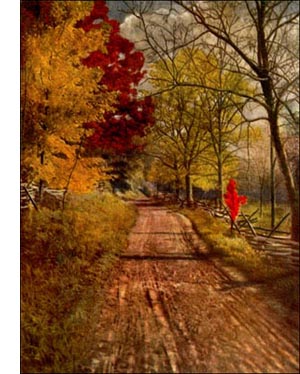Wild Black Cherry or Rum Cherry Tree
 Wild Black Cherry, Rum Cherry (Prunus serotina, Ehrh.) -A large, spreading tree with oblong head and sturdy, rough trunk; branches drooping. Bark dark brown (grey in the South), checked into rough plates, shedding horizontally in curling sheets on branches; bitter taste. Wood reddish brown, hard, light, strong, easily worked, close, lustrous grain. Buds brown, slender, scaly.
Wild Black Cherry, Rum Cherry (Prunus serotina, Ehrh.) -A large, spreading tree with oblong head and sturdy, rough trunk; branches drooping. Bark dark brown (grey in the South), checked into rough plates, shedding horizontally in curling sheets on branches; bitter taste. Wood reddish brown, hard, light, strong, easily worked, close, lustrous grain. Buds brown, slender, scaly. Leaves narrowly oblong, tapering, 2 to 5 inches long, alternate, finely serrate; dark green, shining above, paler beneath; bitter; yellow in fall; petioles slender, short. Flowers, May, small, white, in racemes 2 to 4 inches long. Fruits, September, flattened, pea sized, purple, bitter and sweetish aromatic; skin thick. Preferred habitat, moist, alluvial soil.
Distribution, Ontario to Dakota; south to Florida and Texas. Uses: A most valuable lumber tree; handsome, quick-growing shade and ornamental tree; the fruit, roots and bark yield a tonic drug.
The black cherry is a substantial citizen in any community of trees. In an astonishingly short time the sapling becomes a tree, low trunked, great of girth, and crowned with a dome of graceful, pendulous branches.
The satiny brown bark reminds us of the birches. It has the same slit-like horizontal "breathing holes," and the birches' way of shedding its bark. But a taste, or even a sniff of a twig, or a bit of bark, will decide the point. The cherry birch, which is the species most likely to be confused with the black cherry, has a pleasantly aromatic flavour. The bark of the cherry is bitter as gall.
In old-fashioned home remedies, in patent medicines, and in the prescriptions of regular physicians cherry extracts and decoctions are often met. No spring tonic is seriously expected to rid us of "that tired feeling" unless the tang of wild cherry is there.
Cherry brandies and cordials are put away against an emergency; and cherry bounce is a good old-fashioned beverage that long ago got into the story books. Old settlers, frugal as they were wise, simply chewed the opening buds in the spring "to purify their blood," and to save doctors' bills at the same time.
The chief value, however, of this cherry is its wood. It is beautiful enough when polished to compete in popularity with mahogany and rosewood. Its rich, lustrous brown deepens and softens with age. Woodwork in sumptuously built houses, parlour cars and steamships is often done in cherry. Fine furniture is made of it.
Small pieces are used in inlay work, for tool handles, and the like. It is so costly that it is largely used in veneering cheaper woods. A sharp look on unfinished edges of chairs, bureau drawers and similar articles will detect this. Birch furniture, which is much cheaper and more crude in colour, is often sold under the name of "solid cherry" or "solid mahogany."
As a shade and ornamental tree the black cherry is charmingly unconventional. It is somewhat wayward in habit and sparse in foliage, but it carries neither trait to extremes. The foliage mass is carried with the grace of a willow, for the leaves are narrow and pointed, and they hang on slender petioles.
While the opening leaves are still red the flowers come on, in dainty, erect racemes that bloom from the bottom upward to the top. The heavy fruits invert the clusters, and remain until late summer. They are sweet and not unpleasant in flavour, eaten before they are thoroughly ripe by birds and by children.